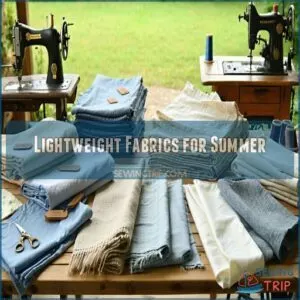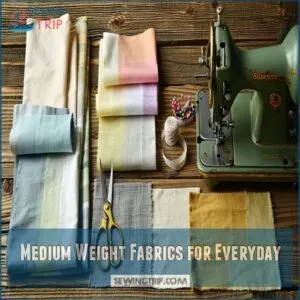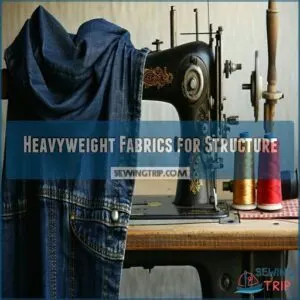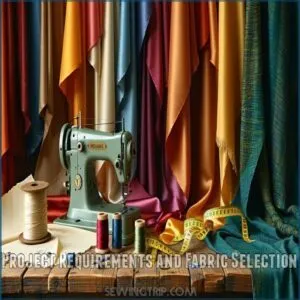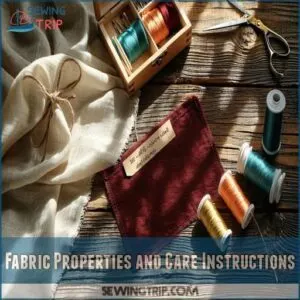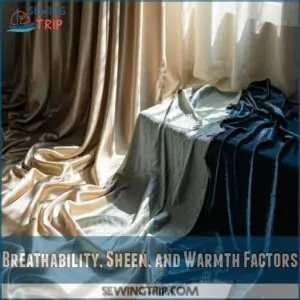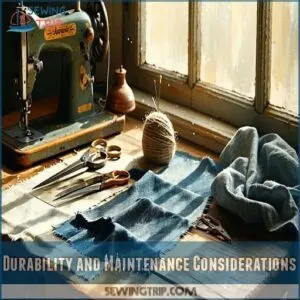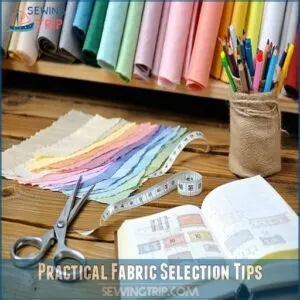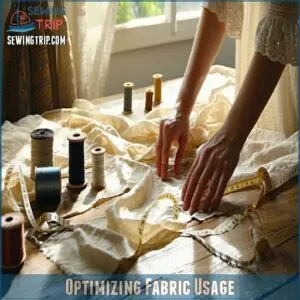This site is supported by our readers. We may earn a commission, at no cost to you, if you purchase through links.
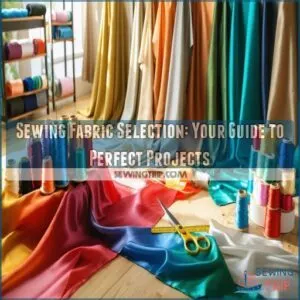 Sewing fabric selection doesn’t have to feel like finding a needle in a haystack.
Sewing fabric selection doesn’t have to feel like finding a needle in a haystack.
You’ll want to match your fabric to your project’s needs – cotton brings breathable comfort perfect for summer wear, while polyester offers durability that’ll stand up to heavy use.
Think about weight too: lightweight fabrics flow like water, while heavyweight materials provide structure for jackets and coats.
Natural fibers like cotton are beginner-friendly, while silk and wool add sophistication to advanced projects.
The right fabric can make your creation sing – and there’s a whole world of creative possibilities in understanding how different materials drape, stretch, and shine.
Table Of Contents
Key Takeaways
- You’ll need to match your fabric to your project’s requirements – cotton offers breathability for summer wear, while polyester provides durability for heavy-duty items.
- Your fabric’s weight drastically impacts the final result – lightweight fabrics flow freely for dresses, medium-weight works for everyday wear, and heavyweight adds structure for coats and jackets.
- You should test your fabric’s drape and stretch before cutting – drape affects how the garment flows on the body, while stretch (2-way or 4-way) determines fit and comfort.
- You’re better off pre-washing your fabric and checking grainlines – this prevents unwanted shrinkage and ensures your finished piece hangs correctly.
Fabric Types Matter
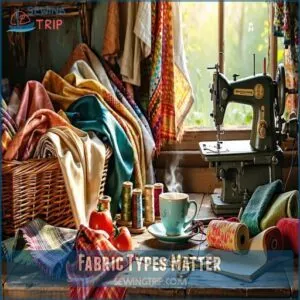
You’ll find that your fabric choice dramatically affects how your project looks, feels, and holds up over time.
So, let’s explore the wonderful world of fabrics and learn how to pick the perfect one for your next sewing adventure!
Natural Fibers Like Cotton
For breathable comfort, consider natural fibers like cotton.
Cotton benefits include its natural texture and fabric softness, making it perfect for eco-friendly projects.
Breathable materials are key for comfy clothes.
When selecting fabric projects, you should evaluate various factors for the best results.
- Cotton is a popular choice for fabric selection.
- Natural fibers offer breathability.
- Explore various cotton fabric types for your next project.
Synthetic Fibers Like Polyester
Beyond natural fibers, synthetic materials like polyester offer unique advantages.
Polyester, a popular choice among synthetic fabrics, boasts impressive fabric durability. From circular knit to terry loop, polyester blends offer diverse textures and properties.
Consider polyester for its chemical resistance and easy care, making it a practical choice for various fabric types and projects.
To learn more about polyester fabric selection, understanding its properties is key. This manmade textile comes in a spectrum of weights, perfect for anything from breezy blouses to sturdy upholstery.
Luxury Fibers Like Silk
Indulge in the allure of silk, a luxurious textile known for its smooth texture and elegant sheen.
Silk production is a detailed process, resulting in high-end materials perfect for blouses and dresses.
Understanding silky properties is not present, instead understanding silk’s unique fabric properties is key to fabric selection.
From chiffon’s ethereal drape to taffeta’s crisp structure, explore the variety of exclusive fibers and elevate your sewing projects with these natural fabrics.
Seasonal Fibers Like Wool
From silk’s smooth elegance, we move to the cozy embrace of wool.
When winter’s chill sets in, wool is your go-to fabric. This natural fiber offers superb insulation, making it perfect for cold weather fabrics and winter textiles.
Explore wool blends for diverse textures and breathable warmth in your seasonal knitting projects.
Understanding wool’s fabric properties is key for smart fabric selection.
Consider Fabric Weight
You’ve picked your perfect fabric type, but don’t stop there—fabric weight matters just as much.
Choosing the right weight can make or break your project, so let’s explore how ounces (or grams) can dramatically impact your sewing success.
Lightweight Fabrics for Summer
Beyond fabric types, weight matters too!
When choosing lightweight fabrics for summer, breathability is key.
Think cotton, linen—your skin will thank you.
Considering the summer dress fabrics is essential for ideal comfort.
Here’s a breezy breakdown of summer fabric choices:
- Cotton: A classic for a reason.
- Linen: Airy and chic.
- Silk: Luxurious and surprisingly breathable.
- Chambray: Lightweight denim feel.
- Rayon challis: Drapey and soft.
Medium Weight Fabrics for Everyday
After exploring airy summer fabrics, let’s talk everyday heroes: medium-weight textiles.
These versatile fabrics (8-10 oz) like mediumweight cotton are your go-to for casual sewing.
Think comfy tees, skirts, or even quilting!
| Fabric Choices | Description |
|---|---|
| Mediumweight Cotton | Soft, breathable, easy care |
| Linen Blends | Crisp, textured, perfect for warm weather |
| Rayon Challis | Drapey, fluid, ideal for blouses |
Heavyweight Fabrics for Structure
Need sturdy pieces? Heavyweight textiles (11-14 oz) bring structure to your sewing projects.
Think denim jackets, winter coats—anything needing some backbone.
Here’s the heavyweight lowdown:
When selecting heavyweight fabric options, consider the density for ideal results.
- Fabric density matters for structured garments.
- Heavy textiles create strong, sharp lines.
- Consider fabric weight and drape for the best results.
- Durability is key with heavyweight fabric selection.
Fabric Drape and Stretch
Now that you’ve got fabric weight down, let’s see how drape and stretch affect your project.
From a slinky bias-cut dress to comfy leggings, the way your fabric falls and flexes makes all the difference.
You’ll learn how to test for drape and understand the magic of 2-way vs. 4-way stretch, opening up a world of sewing possibilities.
Measuring Fabric Drape
Beyond fabric weight, "fabric drape" dictates how a garment flows.
Evaluating fabric flow is key for garment type, and methods like the Cusick Drapemeter quantify drape by analyzing fabric folds, which helps determine the fabric drape characteristics.
A higher drape coefficient translates to stiffer fabric drape characteristics.
Want a flowing skirt? Look for a low coefficient!
Understanding Fabric Stretch
Now that you’ve mastered the drape, let’s talk stretch.
Fabric stretch—how much it gives—is key for fit and comfort.
For a closer examination of drape, see this helpful fabric drape and texture guide.
Stretch percentage importance is huge; it tells you how much the fabric will expand.
Measuring fabric stretch involves checking how much it stretches and in which direction.
Knit fabrics have natural stretch thanks to their looped structure, while elastane or spandex give woven fabrics their stretch.
Stretch type considerations and stretch impact on projects are important for choosing the right fabric.
2. Way and 4-Way Stretch Fabrics
Understanding fabric stretch is key for sewing success.
2-way stretch fabric stretches along one direction, like lengthwise, perfect for skirts.
4-way stretch, like your favorite leggings, stretches both ways—length and width, making it ideal for activewear and knit fabrics needing maximum flexibility.
Knowing your stretch fabric types and their stretch percentage opens a world of sewing possibilities, especially with maximum flexibility.
Knit and Woven Fabric Differences
Knit fabrics, like your favorite comfy tee, stretch thanks to their looped fiber construction.
Woven fabrics, think crisp linen, have less give because of their interlaced structure.
For more information, explore these knit fabric properties.
This key structure difference impacts drape characteristics and seam properties.
Stretch comparisons are important for fabric selection; choosing the right fabric type, knit or woven, depends on your project.
Choosing The Right Fabric
Picking the right fabric can make or break your project, so let’s explore how to choose wisely.
You’ll learn about matching fabric properties to your project’s needs, from flowy dresses to sturdy jackets.
Ensuring your creations turn out exactly as you envisioned, with the right choice being crucial for a successful project.
Project Requirements and Fabric Selection
Now that you’ve got a handle on drape and stretch, let’s nail fabric selection for your sewing projects.
Think about your intended garment—a flowy dress needs a different fabric than structured jeans.
Consider the desired drape, fabric suitability, and care requirements.
Budget constraints matter too!
Smart sewing fabric selection means balancing project matching with your wallet.
Fabric Properties and Care Instructions
So, you’ve nailed down your project’s needs—great!
Now, let’s tackle fabric properties and care. Prewashing natural fibers like cotton prevents shrinkage.
Always check those fabric care instructions—washing instructions, drying techniques, and ironing methods vary.
Knowing your fiber content and fabric weights is key for proper care.
Treat your fabrics right, and they’ll return the favor!
Breathability, Sheen, and Warmth Factors
When choosing a fabric, consider fiber breathability, fabric sheen, and warmth levels for climate suitability.
Linen’s breezy texture comfort is perfect for summer, while wool’s cozy warmth conquers winter chills.
Fabric breathability and sheen influence both aesthetics and texture comfort, think silky evening gown versus a comfy cotton tee.
Understanding the fabric selection process is important for making informed decisions about the materials used in sewing projects.
Smart fabric selection hinges on understanding these fabric characteristics and textures for sewing success.
Durability and Maintenance Considerations
Considering fabric durability and maintenance is key.
Wash cycles, drying techniques, and ironing temperatures all depend on the fabric.
Proper storage methods prevent wrinkles and damage.
Stain removal techniques and overall fabric maintenance affect the lifespan of your creations.
Always check those care instructions before you start!
Practical Fabric Selection Tips
Want to avoid common sewing pitfalls and guarantee your projects turn out fabulous?
Here’s how you’ll learn to pick the perfect fabric every time, from checking for quality to pre-washing for perfect fits.
Identifying Low-Quality Fabrics
Before you sew, inspect your fabric like a detective!
Low-quality fabrics reveal their secrets through telltale signs.
Look for:
- Uneven weaves that resemble a spider’s broken web.
- Fraying edges like a worn-out friendship bracelet.
- Inconsistent color, a sure sign of textile trouble.
Spotting these fabric characteristics early prevents sewing headaches later.
Don’t let weak threads and unusual smells ruin your sewing fabric selection, prioritize fabric durability for perfect projects, and remember to inspect for telltale signs.
Pre-Washing and Shrinking Prevention
Now that you’ve learned to spot a quality fabric, let’s talk shrinkage.
Ever had a lovingly sewn project shrink after its first wash?
Pre-washing is your insurance policy. This shrinkage testing reveals your fabric’s true post-wash dimensions.
Proper fabric prewashing and following shrinkage prevention tips avoids this sewing heartbreak.
Knowing how your fabric behaves after washing guarantees your project stays true to size.
Aligning Pattern Pieces With Grainlines
Careful pattern alignment keeps your project on track.
Match pattern pieces to the fabric grainlines, using selvage edges as a guide.
This precise approach prevents fabric distortion and guarantees a polished finish.
- Understand grainline direction on sewing patterns.
- Align pattern pieces with fabric grainlines.
- Use selvage edges for accurate placement.
- Prevent fabric distortion with correct cutting layouts.
- Master sewing techniques by respecting the fabric bias.
Using Walking Feet for Slippery Fabrics
Slippery fabrics like satin can be a challenge.
Walking feet, however, offer a game-changer with even feed, this "dual feed" system from your sewing machine, even a Pfaff, prevents slippage and guarantees smooth stitching.
Walking foot benefits include preventing those frustrating fabric pile-ups, especially with a slippery finish, making slippery fabric handling a breeze.
Master these sewing techniques for truly professional results!
Optimizing Fabric Usage
Making the most of your fabric means less waste and fewer mid-project panics when you realize you’re short.
By planning carefully, estimating needs, and using smart cutting techniques, you’ll keep your projects stress-free and your budget in check.
Estimating Fabric Requirements
Getting fabric measurement right can feel like solving a puzzle.
Start by using fabric yardage calculators to determine your project’s needs, accounting for fabric width and desired length.
Don’t forget to add extra for sewing margins and fabric buffers – about 10% more than your calculations suggest.
For precise fabric requirements, multiply the number of pattern pieces by their individual meterage, then round up generously.
Minimizing Fabric Waste and Errors
Now that you’ve measured your yardage, let’s tackle those fabric scraps head-on.
Try nesting pattern pieces like a puzzle master before cutting to maximize your fabric usage.
Fabric estimation tools and yardage calculators help prevent those "oops, ran out" moments.
When sewing mistakes happen, keep those larger scraps for pocket linings or facings.
Smart fabric selection and careful cutting mean less waste and more projects from your stash.
Building a Versatile Fabric Collection
Smart fabric selection starts with building a versatile fabric collection that’ll grow with your skills.
Your fabrics should mix and match like a well-planned wardrobe.
Here’s how to create a powerhouse collection:
- Start with cotton varieties for everyday projects – think quilting cotton, jersey, and poplin
- Add seasonal fabrics like linen for summer and wool for winter
- Include specialty fabrics like silk or velvet for unique texture mixing to achieve unique texture
Budgeting and Planning for Fabric Expenses
You’ve built your fabric collection – now let’s talk money.
Create a dedicated fabric budget and track those expenses like a pro. Consider bulk fabric purchasing during off-season sales for cost-effective fabric choices.
Smart sewists plan their fabric shopping around seasonal deals and keep a spreadsheet of their sewing materials.
Look for affordable fabric alternatives at thrift stores or remnant bins to stretch your budget further with cost-effective choices.
Frequently Asked Questions (FAQs)
What are the 4 things to consider when choosing fabric?
Like picking the perfect ingredients for a recipe, you’ll want to weigh factors such as weight (light to heavy),
stretch (firm or flexible),
drape (how it falls),
and properties (breathability, durability) for your ideal fabric choice.
This approach allows for a careful consideration of the key characteristics that define your ideal fabric, including properties such as breathability and durability.
How do I choose the right amount of fabric?
Check your pattern’s requirements, then add an extra half-yard for pattern matching and mistakes.
Don’t forget to account for fabric width and shrinkage.
Always round up to the nearest quarter-yard when purchasing.
Which fabric is best for my sewing project?
Your project’s soul-mate fabric depends on its purpose.
Consider the garment’s drape, stretch needs, and care requirements, including the choice between lightweight chiffon for flowy dresses, sturdy cotton for everyday wear, or wool for structured pieces.
What are the selection criteria for fabric?
Consider fabric weight, drape, stretch, and care requirements for your project.
Match material properties with garment needs – lightweight fabrics suit flowing dresses, while heavy-duty options work best for structured pieces, considering the material properties.
How do you match thread color with patterned fabric?
Pick thread that matches the dominant background color of the pattern.
For detailed work or contrasting patterns, select a shade from the secondary colors.
Darker thread works best on busy patterns.
Can fabric grain affect the final garment fit?
Yes, fabric grain’s alignment can make or break your garment’s fit.
When you cut against the grain, you’ll notice unwanted stretching and drooping.
Stick to the proper grain direction for a flawless drape.
Which interfacing works best for different fabric weights?
Like matching dance partners, pair lightweight interfacing with delicate fabrics,
medium-weight fusible with cotton blends, and heavyweight stabilizers with thick materials.
You’ll need the right support for perfect structure and movement.
Should you prewash trim and notions with fabric?
Prewash your trims and notions alongside fabric if they’ll be laundered together in the finished project.
You’ll want zippers, ribbons, and lace to shrink now rather than after you’ve completed your garment.
Are fabric marking tools permanent or temporary?
Quick as a chameleon changing colors, fabric marking tools come in both temporary and permanent varieties.
You’ll find water-soluble pens, chalk, and disappearing ink markers that vanish, while permanent markers stick around forever.
Conclusion
Mastering sewing fabric selection is like learning to paint – each material brings its own unique personality to your creative canvas.
Whether you’re drawn to cotton’s breezy comfort or silk’s elegant drape, you’ve now got the know-how to pick the perfect fabric for any project.
Remember to take into account weight, stretch, and care requirements as you build your collection.
Trust your instincts and don’t be afraid to experiment – every stitch brings you closer to creating exactly what you’ve envisioned.
- https://www.sewessential.co.uk/blog/how-to-choose-the-right-fabric/
- https://www.seamwork.com/articles/5-tips-to-choose-the-right-fabric-for-your-sewing-project
- https://collectivegen.com/2017/08/choose-right-fabrics/
- https://www.moodfabrics.com/blog/how-to-choose-the-right-fabric-for-your-project/
- https://www.internationalquiltmuseum.org/

